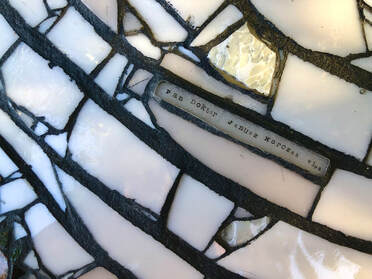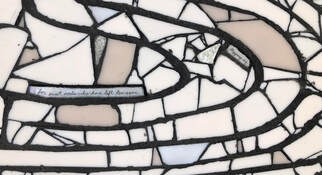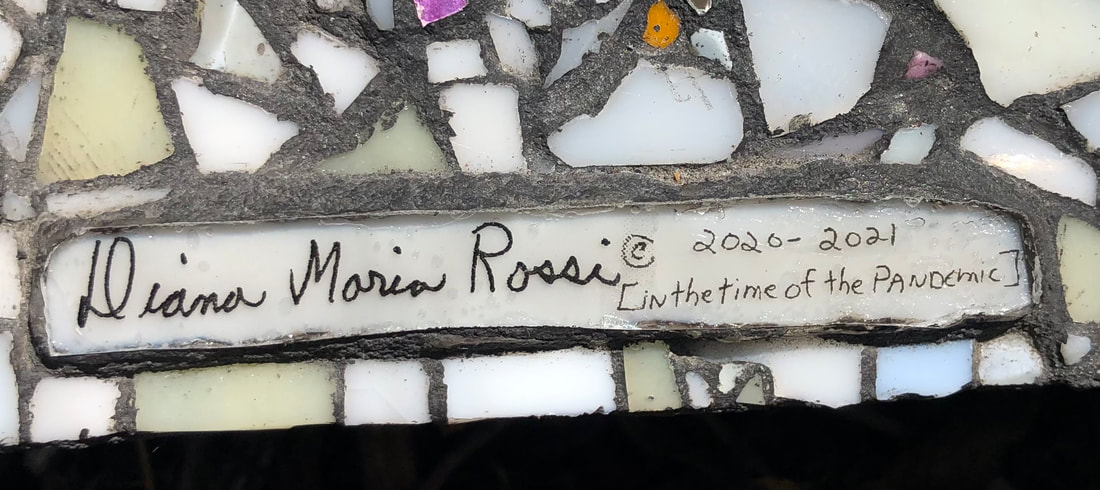Good Fortune: Tails (from a Pandemic)
In September of 2020 when it was proposed that I submit a design for a new mosaic mural that would symbolize the backside of "Good Fortune", I said, "yes", hesitantly. For what could possibly be on the reverse side of "Good Fortune" anyway? and would
I even want to go there with my art? All kinds of scenarios presented themselves to me. I looked at the song that I had based "Good Fortune" on and was inspired by ---- There was nothing new for me there at that point. I probably was not capable of making that same piece that I made in 2002 in 2020. So I let myself get even more literal, picked up a copper penny, and what do I see?: "e pluribus unum" inscribed on the tail side --- on every penny, on every U.S. coin, even! -- out of many one or one from many. This even happens to be the unofficial original motto of the U.S., and what a lofty goal, these United States!
But we seem to have drifted so far from this ideal. We have gone from an idea that was real for my parents' generation, at least, (1920's born people, a century ago) to we citizens of the 2020's where some of us think our state lines are values' demarcation lines.
So, so hopeful, on every little penny....
During this time period, while I was mulling this over, Ruth Bader Ginsberg died and we were treated to media clips from her life, included one where she gave a speech at a naturalization ceremony at the New York Historical Society in 2018 in which she mentions the phrase "e pluribus unum". And that was the sign I needed in order to go ahead and to utilize "e pluribus unum" as the unifying theme.
I even want to go there with my art? All kinds of scenarios presented themselves to me. I looked at the song that I had based "Good Fortune" on and was inspired by ---- There was nothing new for me there at that point. I probably was not capable of making that same piece that I made in 2002 in 2020. So I let myself get even more literal, picked up a copper penny, and what do I see?: "e pluribus unum" inscribed on the tail side --- on every penny, on every U.S. coin, even! -- out of many one or one from many. This even happens to be the unofficial original motto of the U.S., and what a lofty goal, these United States!
But we seem to have drifted so far from this ideal. We have gone from an idea that was real for my parents' generation, at least, (1920's born people, a century ago) to we citizens of the 2020's where some of us think our state lines are values' demarcation lines.
So, so hopeful, on every little penny....
During this time period, while I was mulling this over, Ruth Bader Ginsberg died and we were treated to media clips from her life, included one where she gave a speech at a naturalization ceremony at the New York Historical Society in 2018 in which she mentions the phrase "e pluribus unum". And that was the sign I needed in order to go ahead and to utilize "e pluribus unum" as the unifying theme.
I began work on a design --- a collar shape, a necklace, linked parts of a whole --- the oval-ish shape appeared to me in my mind's eye and I began to picture it (there IS a muse!). I toyed with that idea.
But as I began the preliminary sketch for this idea, a beloved cousin of mine died, and because of Covid travel restrictions, attending her funeral was out of the question for me. I was verklempt, so sad. The last thing that I wanted to do was design a public art piece. I languished for a bit, considered putting the whole project aside, but then I was able to conjure up the voice and sprit of my Cousin: "How can you pass up this opportunity to speak to a wider audience?"; "How can you look this
gift horse in the mouth? and throw away this opportunity?"; "Who did I think I was?". Actually my cousin never would have said
that last bit to me --- she was much too kind, respectful and nurturing towards me. That is more MY voice! But
I heeded these sentiments and the voice of my Cousin Carol as Muse and looked at what I had been drawing.
"Oh my!" I thought. That negative space inside the oval-ish shape is just perfect for a labyrinth. For you see, for the last several years, I had associated the idea of labyrinths with my cousin and her sister. This stemmed from a San Francisco visit where we walked the Grace Cathedral outdoor labyrinth together. While we were walking this maze, we spontaneously burst into song, a Polish hymn from our school days. We still knew the Polish lyrics! It was a magical moment, hard to put into words, that none of us forgot.
Thus, I would continue with my work on the other tail side of "Good Fortune" and that internal oval-ish space would become a labyrinth.
A key component of a labyrinth is that there is one entry and one center. A labyrinth and the traveling of one is about the process of meandering a fixed path to one center or whole. This concept seems to complement the idea of "out of many, one" or "one from many". And did you know that there are You Tube videos on how to draw a labyrinth? The labyrinth in this piece is accurate and one can finger travel it from beginning to end.
gift horse in the mouth? and throw away this opportunity?"; "Who did I think I was?". Actually my cousin never would have said
that last bit to me --- she was much too kind, respectful and nurturing towards me. That is more MY voice! But
I heeded these sentiments and the voice of my Cousin Carol as Muse and looked at what I had been drawing.
"Oh my!" I thought. That negative space inside the oval-ish shape is just perfect for a labyrinth. For you see, for the last several years, I had associated the idea of labyrinths with my cousin and her sister. This stemmed from a San Francisco visit where we walked the Grace Cathedral outdoor labyrinth together. While we were walking this maze, we spontaneously burst into song, a Polish hymn from our school days. We still knew the Polish lyrics! It was a magical moment, hard to put into words, that none of us forgot.
Thus, I would continue with my work on the other tail side of "Good Fortune" and that internal oval-ish space would become a labyrinth.
A key component of a labyrinth is that there is one entry and one center. A labyrinth and the traveling of one is about the process of meandering a fixed path to one center or whole. This concept seems to complement the idea of "out of many, one" or "one from many". And did you know that there are You Tube videos on how to draw a labyrinth? The labyrinth in this piece is accurate and one can finger travel it from beginning to end.
My Dedication
I connected this new piece, which became "Good Fortune: Tails (from a Pandemic) to "Good Fortune" by continuing the penny
motif. This time, though, instead of using children's photos, ringed with copper Venetian smalti, as symbolic pennies,
I used the real deal --- 67 pennies. Each penny is mounted under clear glass, placed tail side up and surrounded by a ring of mosaiced glass of different colors. There are approximately 8 different ring colors plus every 6th penny is circled by a black corona of triangles. Nineteen years have passed since “Good Fortune” was first installed, so the 67 is representative of the 48 pennies of “Good Fortune” (the heads/faces of children), plus the passage of time, those 19 years.
motif. This time, though, instead of using children's photos, ringed with copper Venetian smalti, as symbolic pennies,
I used the real deal --- 67 pennies. Each penny is mounted under clear glass, placed tail side up and surrounded by a ring of mosaiced glass of different colors. There are approximately 8 different ring colors plus every 6th penny is circled by a black corona of triangles. Nineteen years have passed since “Good Fortune” was first installed, so the 67 is representative of the 48 pennies of “Good Fortune” (the heads/faces of children), plus the passage of time, those 19 years.
I punctuated the background with 13 medallions, in order to break up the space. I began with the idea of using 12 photos of squirrels (this was to be installed in a playground at Live Oak Park, after all) plus a photo of one opossum. [I was making my peace with the opossum, "Yelda", who lives/lived in my garage where I began work on this piece.]
Why 13? you ask? —- 13 original US colonies, a baker’s dozen, a lucky unlucky number....
But then, a lot of living and working happened over the course of those seven months of mosaicing. It was this living, dying
and working through a global pandemic, taking its toll on all of us, that prompted my use of other animal photos among the 13 medallions. I decided to branch out from the original squirrel symbols and incorporate the use of other animal photos, spirit animals, perhaps? as symbolic for specific souls who have personally affected me. I don't think that I could have completed this piece without acknowledging the losses that we have experienced individually and collectively.
Why 13? you ask? —- 13 original US colonies, a baker’s dozen, a lucky unlucky number....
But then, a lot of living and working happened over the course of those seven months of mosaicing. It was this living, dying
and working through a global pandemic, taking its toll on all of us, that prompted my use of other animal photos among the 13 medallions. I decided to branch out from the original squirrel symbols and incorporate the use of other animal photos, spirit animals, perhaps? as symbolic for specific souls who have personally affected me. I don't think that I could have completed this piece without acknowledging the losses that we have experienced individually and collectively.
With Love
I made the background of various hues of whitish glass -- mainly, pink, yellow, blue, gray. But I interspersed the background
with wee bits of all the colors of the rainbow to give the appearance of confetti (or Funfetti©, a trademarked Pillsbury brand of rainbow sprinkles in a field of white frosting). To this, I also added in bits of mirror, (78 pieces, to be exact), in
order to attract light. Those 78 pieces are stars.
with wee bits of all the colors of the rainbow to give the appearance of confetti (or Funfetti©, a trademarked Pillsbury brand of rainbow sprinkles in a field of white frosting). To this, I also added in bits of mirror, (78 pieces, to be exact), in
order to attract light. Those 78 pieces are stars.
During the seven months of mosaicing (except for one week off), I worked almost every day. And as I worked, I was able to listen to many, many audio books courtesy of the Berkeley Public Library. For most of the time, I was on a World War II streak. I think that this was how I was attempting to put the Covid Pandemic in perspective --- trying to understand another time in the recent past, another era when the world was in an upheaval.
One of the better books that I listened to was The Good Doctor of Warsaw an historical novel by Elisabeth Gifford which was about the Warsaw Ghetto and a man with the pen name of Janusz Korczak (his given name was Henryk Goldszmit),who ran an
orphanage for Polish Jewish children in the Ghetto. In 1942, Janusz Korczak accompanied "his children" from the orphanage to the trains that would take them to the Treblinka extermination camp. He did this in lieu of accepting sanctuary to free himself, because he did not want to abandon his children. Janusz Korczak/Henryk Goldszmit was murdered at Treblinka along with 192 or 196 (accounts differ) orphaned children who had resided at the orphanage. He was often called "Pan Doktor" (Mr. Doktor) or "Stary Doktor" (Old Doctor) and was known as an educator, children's author, pediatrician and defender of children's rights whose work was seminal in changing how we look at children as people. In fact, his writings contributed to the thinking that helped establish the Convention of the Rights of the Child adopted by the United Nations in 1989.
One of the better books that I listened to was The Good Doctor of Warsaw an historical novel by Elisabeth Gifford which was about the Warsaw Ghetto and a man with the pen name of Janusz Korczak (his given name was Henryk Goldszmit),who ran an
orphanage for Polish Jewish children in the Ghetto. In 1942, Janusz Korczak accompanied "his children" from the orphanage to the trains that would take them to the Treblinka extermination camp. He did this in lieu of accepting sanctuary to free himself, because he did not want to abandon his children. Janusz Korczak/Henryk Goldszmit was murdered at Treblinka along with 192 or 196 (accounts differ) orphaned children who had resided at the orphanage. He was often called "Pan Doktor" (Mr. Doktor) or "Stary Doktor" (Old Doctor) and was known as an educator, children's author, pediatrician and defender of children's rights whose work was seminal in changing how we look at children as people. In fact, his writings contributed to the thinking that helped establish the Convention of the Rights of the Child adopted by the United Nations in 1989.
The cobalt blue line is a repetition of the very blue feel of “Good Fortune” bleeding over to the back. In fact, for most of
this blue edging, I used the same cobalt blue tesserae that had been rimming the edge of "Good Fortune". I had to
remove the edges (coving the width) in order for "Good Fortune" to be installed within its niche.
this blue edging, I used the same cobalt blue tesserae that had been rimming the edge of "Good Fortune". I had to
remove the edges (coving the width) in order for "Good Fortune" to be installed within its niche.
"Good Fortune: Tails (from a Pandemic)" installed on a wall in Live Oak Park, Berkeley, California, September 23, 2021
This mosaic and its companion piece on the other side, "Good Fortune" were installed by Riley Doty and Phylece Snyder. It was a pleasure to work with them and benefit from their expertise, attention to detail and conscientiousness.
This is a Polish expression meaning "hang in there". I thought rounding a curve in a labyrinth might be a good place for this sentiment, a sentiment which was freely dispensed as a parting expression by the Polish side of my family.
My work companion laying claim to her territory before our labors go out into the world.....
Please click on any image for a larger view.


























